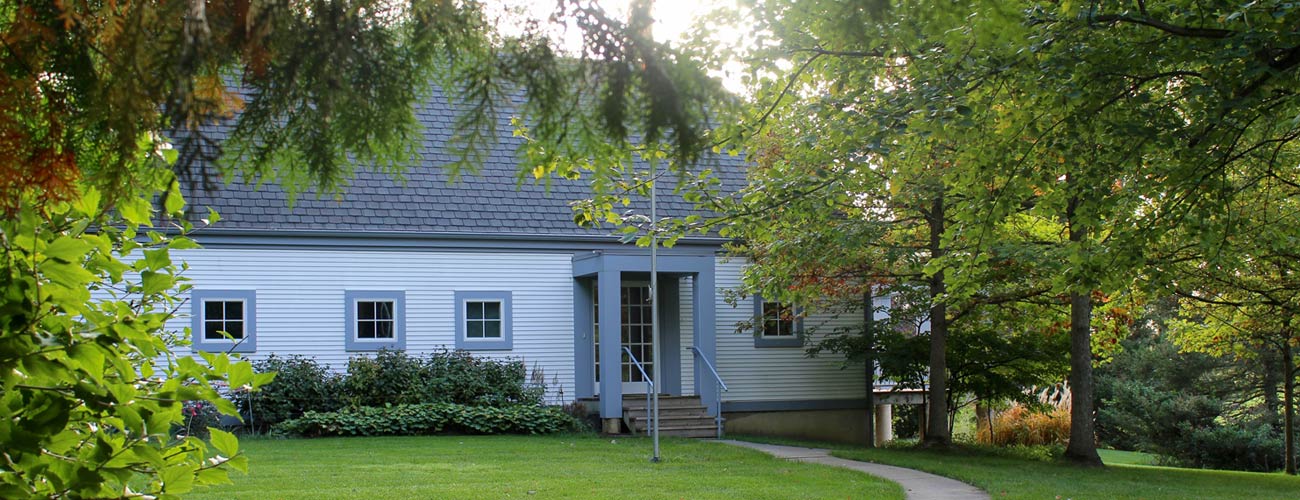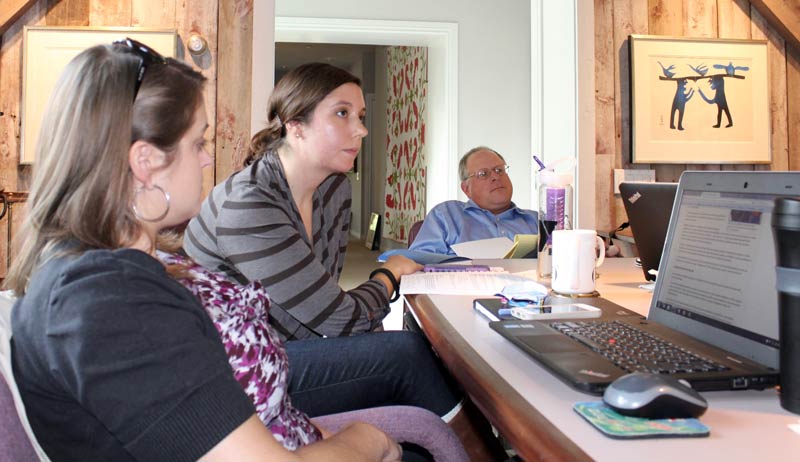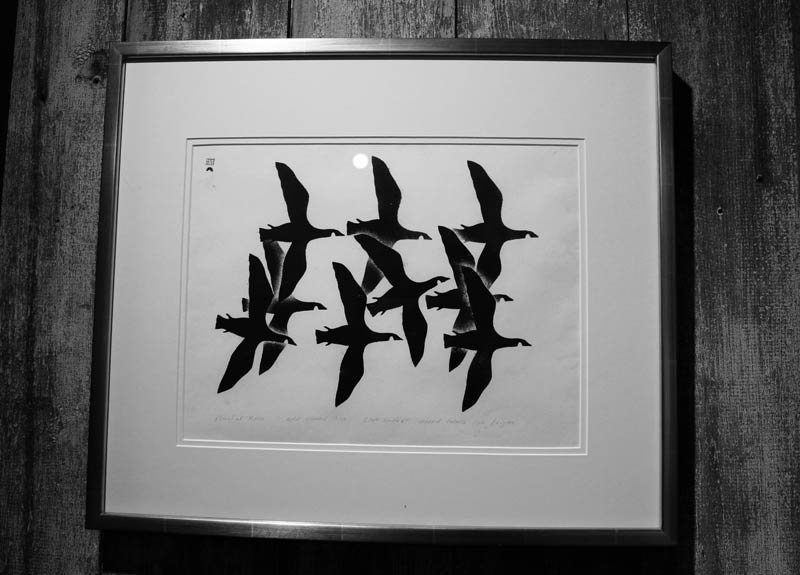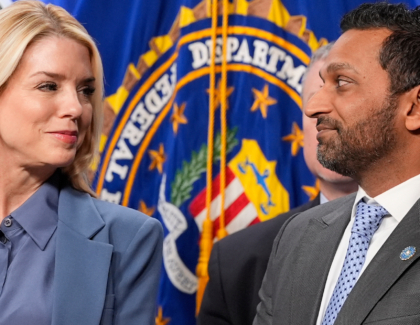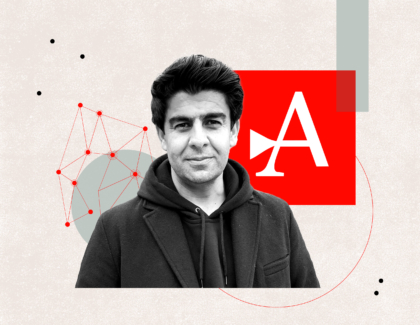Sign up for the daily CJR newsletter.
On a Thursday morning in October, Nancy Nall Derringer, a staff writer for Bridge Magazine, brought a homemade apple coffee cake to a story meeting. The nonprofit online publication has offices in Lansing and Detroit, but this gathering was at the publication’s home base—a cottage in a wooded area of Ann Arbor, built with reclaimed lumber from a local barn and expansive windows that bring in natural light. Just up the hill is the home of Phil Power, the founder of Bridge’s parent organization and the site’s primary funder. Framed Inuit art hangs on the cottage walls, part of a Power family collection that was begun decades ago.
“Well, you know me,” Derringer said, as her colleagues settled their laptops and coffee cups around the conference table. “It’s Teddie’s Apple Cake, a New York Times recipe.”
“Yeah, good, I don’t want that USA Today shit,” said senior editor David Zeman. As the staff broke into laughter, someone speculated about what a “bullet-point cake” would be like.
Whatever it is, you won’t find it here. Not much bullet-point journalism, either. Launched in September 2011 as an initiative of the Center for Michigan, a nonprofit, centrist “think and do tank,” Bridge has grown into a haven of sorts for veterans of the state’s shrinking newspapers: a place where the budget is growing, the staff is expanding, the pace of publication is not frenetic, and free-ranging editorial meetings lead to heavily reported stories on policy issues affecting the people of Michigan. It’s a recipe that has some limitations, but overall, it appears to be working pretty well. Four years after its launch, Bridge can boast of a rising digital audience, increasing exposure in other media, and a bunch of awards.
Bridge “does some of the most in-depth reporting in the state,” Zoe Clark, an executive producer for the Michigan Radio show Stateside, wrote me via email. The public radio station often features Bridge on its programs. “Rather than ‘he said-she said’ reports, they spend weeks at a time doing research, interviews, looking at numbers, building spreadsheets,” Clark added.
“Every other publication has cut staff, cut money,” said Bill McGraw, who worked for decades for the Detroit Free Press and then cofounded the startup Deadline Detroit before joining Bridge as a reporter this year. “They’re growing, and growing by any measurement.”
Bridge staffers discuss ideas during a recent story meeting. From left are business reporter Lindsay VanHulle, outreach director Amber DeLind, and John Bebow, president and CEO of the Center for Michigan.
Like many of its counterparts in the world of nonprofit media, Bridge’s mission is to fill a void in statewide journalism with in-depth reporting. Its approach to that goal is a mix of old-fashioned and of-the-moment. The site embraces many of the trends in the field: civic engagement, data reporting, mapping, collaboration, a focus on solutions. Staff members often work from home or on the road, rather than the offices. At the same time, reporters are not obliged to have a constant social media presence, Bridge’s website has a decidedly vintage look about it, and the digital magazine’s approach to public engagement leans analog: A three-person team hosts community meetings around the state, gathering feedback that informs Bridge’s editorial choices.
And, as McGraw says, it’s growing. Since it launched, Bridge’s staff has tripled to nine employees, including Power and John Bebow, the president and CEO of the Center for Michigan, who is himself a former investigative reporter for several newspapers. The Center’s annual budget is now $2.25 million, a ninefold increase from when it was founded, and about half of the current budget is devoted to Bridge, said Bebow. That sum is sourced from Power, foundation grants, and $50,000 in individual donations—no ads, at least not yet.
The online audience is growing, too: The site has more than half a million unique visitors between January and early October, a significant increase over the early days. Many other readers see Bridge articles at MLive.com and Crain’s Detroit Business; earlier this year, Crain’s and Bridge partnered to jointly hire a business beat reporter.
The stories those readers encounter, published in editions several days a week on the Bridge site, are increasingly ambitious. A “Poverty in Paradise” series, published in February, looks at inequality in and around Northern Michigan’s tony resort communities. Another series looks at drinking on college campuses, with an emphasis on the public health and business angles. And though the focus is on Michigan, Bridge’s journalists looks for lessons beyond the state’s borders. Mike Wilkinson, the computer-assisted reporting specialist, traveled to Nebraska to report on how one college campus reduced drinking by a third. The “Poverty in Paradise” series explored affordable housing efforts in liberal Aspen, Colorado, and conservative Jackson Hole, Wyoming.
We’re still figuring out who we are, compared to what we used to do at the Detroit News or the Detroit Free Press. It’s the same game, but different skills.”
“We’re only four years old,” said Ron French, the first reporter hired by Bridge. He was addressing the whole staff toward the end of the story meeting. “We’re still figuring out who we are, compared to what we used to do at The Detroit News or the Detroit Free Press. It’s the same game, but different skills.”
As it evolves, Bridge has a foundation of financial stability. Power has guaranteed the publication one million dollars a year through the year 2025. That wealth is thanks in part to the ingenuity of Power’s father, Eugene, who founded a company that pioneered the use of microfilm to store information. The company was bought by Xerox in 1962 and is now part of ProQuest.
Phil Power isn’t just a man with a hobby, however. He cut his teeth as a reporter at an Alaskan newspaper, and founded a chain that eventually owned more than sixty community newspapers. He sold to Gannett in 2005, soon before he founded the Center for Michigan. (One other note from Power’s biography: He campaigned in 1978 as a Democratic candidate for the US Senate, but was bested by Carl Levin in Levin’s first election to the office he would hold until January of this year.)
Power has said one of his goals with the Center was to support a “citizens’ movement that pushes both political parties,” and a sensibility that intractable problems can be solved through greater civic engagement and a focus on what works runs through Bridge’s output. (One of the site’s news categories is “Success.”) But Bridge eschews the notion of advocacy journalism. “You don’t have credibility” as an advocate, Bebow said. McGraw told me he’s never felt like he needed to voice any particular viewpoint in his stories. “You just do the stories you want to do.”
And though Power and Bebow set the vision, there is a “flatness” to the organization, said Zeman, who edited Pulitzer Prize-winning reporting at the Free Press before joining Bridge. “Whether it’s about stories or our health care plan or our next conference,” he said, “there’s enough trust here that if we tell John or Phil they’re full of shit, we’re not going to be out in Siberia the next day.”
Framed art hangs on the cottage walls.
That “flatness” was on display at the recent story meeting. While offering slices of her apple cake, Derringer warned me that it would last for three hours, and indeed it did. In turn, each writer discussed his or her ideas for the coming months, sparking staff-wide input on how their stories might be approached. Zeman asked Bebow what he was seeing in Lansing. Bills moving forward in the capital and shifts in political influence were examined for hooks. A member of the public engagement team had ideas for the others that emerged from her community meetings. One reporter described a possible political profile and finished by saying, “I think that’s the obvious angle.” In a whisper, Zeman said, “Damn the obvious angle.”
“These conversations did not happen at the News or the Free Press,” Wilkinson told me afterward. “Reporters came up with story ideas and talked about them with an editor.”
As they look to the future, the Bridge team knows their website is in need of an overhaul. There are plans for new beats, too. In an email to me, Power said that health, the environment, and more business coverage are on the radar. There’s interest in new collaborations with other media outlets, and in working more with the Arizona State University Center for Games and Impact, which helped to develop a budget-balancing game for the Center for Michigan in 2011. Over about six weeks, 10,000 people played it.
Then there is the challenge of reaching a more economically diverse readership. One of the site’s measures of success is influencing political elites—Bebow looks for how Bridge stories are used in conversations among legislators in Lansing and other decision-makers in the state. It’s a worthy goal, but it’s also no surprise that, according to Bebow, Bridge’s readership skews to affluent.
Those demographics were evident in a joking comment from Zeman at the story meeting: “I swear, we should put Traverse City in every story,” he said, referring to the pretty northern community that is beloved by wealthy vacationers. “Seven of our top ten stories are about Traverse City.” In seeking a broader and more diverse audience, Bridge may be able learn from peers in the Institute for Nonprofit News, which the magazine recently joined, Bebow said. But, he added, “we’re so focused on place and policy, we’d probably learn a lot more just by being better sourced.”
I asked Bebow if his old buddies in the newspaper business give him guff about Bridge poaching their talent. “I have friends at newspapers who call and ask when the next opening is,” he replied. He quickly added that he think it’s “heroic” what today’s newspaper reporters do while working at the pace the industry demands. But Bridge stands out by giving reporters time to think and reflect. “That’s why we exist,” he said. After all, if everything were great in the news business, they wouldn’t need to be here.
Has America ever needed a media defender more than now? Help us by joining CJR today.



